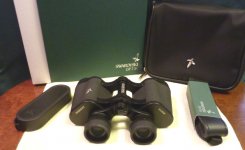Well, I was not really looking for one of these but couldn't pass it up. Swarovski habicht 8x30W porro, bought new this year, £629 from Clifton Cameras, never used, boxed, paperwork, as it was originally sold, with reciept, for sale at £469, but wait, I had a 15% discount voucher, so got it for £398. Maybe I bought from someone on here, i'm really pleased to have got it though. Now, I have a few good 8X30 porro's in the collection, including the Nikon E11, Kern Pizar, Leitz Binuxit, Zeiss Oberkochen. I have posted before comparison, but in short, for me personally the Nikon E11 was overall the best, although the Kern is the brightest. Now I had the chance to finally compare the E11 with the Habicht.
Well plenty has been written on the merits of both so I will just stick to what I found. They are both superb, and there is really little in it in my opinion. The Habicht is fractionally brighter, (but not as bright as the Kern), the E11 to me, has fractionally better colour depth, but in both respects it is marginal and only to my eye. The 462ft@1000yds Fov of the E11 beats the Habicht 408ft hands down. The Habicht is waterproof to 4m, the E11 is not. Clarity and detail are to me, about the same, nothing in it. The E11 is smooth focusing, the Habicht a little stiff, maybe due to being watertight. The EII to me, seems a more relaxed view, probably due to wide FOV. I have no problems with glare or CA with either binocular. The build quality of the Habicht appears to me to be a fair bit better than the E11. This is just my personal finding, I know people differ, but I am somewhat surprised to have to say, that although it does not exude the quality of the Habicht, to me the Nikon E11 is overall still the best 8x30 porro for practical use. So, if you are looking for a good 8x30 porro, and you are considering, the admittedly excellent Habicht, my advice would be that unless you desperately need a waterproof binocular, go compare with the E11 first, not only is it half the price of the Habicht, but in my humble opinion it is overall better to use. If you compare you may find it is the same for you.
Well plenty has been written on the merits of both so I will just stick to what I found. They are both superb, and there is really little in it in my opinion. The Habicht is fractionally brighter, (but not as bright as the Kern), the E11 to me, has fractionally better colour depth, but in both respects it is marginal and only to my eye. The 462ft@1000yds Fov of the E11 beats the Habicht 408ft hands down. The Habicht is waterproof to 4m, the E11 is not. Clarity and detail are to me, about the same, nothing in it. The E11 is smooth focusing, the Habicht a little stiff, maybe due to being watertight. The EII to me, seems a more relaxed view, probably due to wide FOV. I have no problems with glare or CA with either binocular. The build quality of the Habicht appears to me to be a fair bit better than the E11. This is just my personal finding, I know people differ, but I am somewhat surprised to have to say, that although it does not exude the quality of the Habicht, to me the Nikon E11 is overall still the best 8x30 porro for practical use. So, if you are looking for a good 8x30 porro, and you are considering, the admittedly excellent Habicht, my advice would be that unless you desperately need a waterproof binocular, go compare with the E11 first, not only is it half the price of the Habicht, but in my humble opinion it is overall better to use. If you compare you may find it is the same for you.





